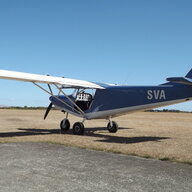Conducted minor experiment with digital scales:
Weighed self on the flat, then placed scales on rigid board, chocked up at one side so scales are no longer hortizontal, and weighed self again.
As the board is tilted up, the scales progressively underweigh.
So unless something is done to ensure no lateral load on the scales, the scales will underweigh.
Which could explain some of the unlikely low weights reported in other threads.
In the case of the Savannah, if lifting and lowering the main UC wheels as I did for successive weighings, that means either preventing the UC from spreading when the wheel comes down, or arranging for the scales to move sideways, as Turboplanner did above. Or rolling on, provided that can be done smoothly.


